A Brief Colonial History Of Ceylon(SriLanka)
Sri Lanka: One Island Two Nations
A Brief Colonial History Of Ceylon(SriLanka)
Sri Lanka: One Island Two Nations
(Full Story)
Search This Blog
Back to 500BC.
==========================
Thiranjala Weerasinghe sj.- One Island Two Nations
?????????????????????????????????????????????????Saturday, July 1, 2017
Breast cancer
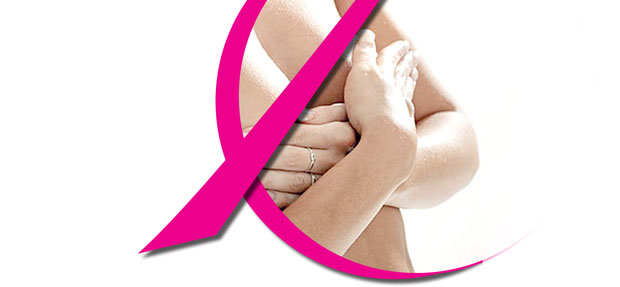
 2017-06-28
2017-06-28
 Breast
cancer is a type of cancer developing in breast cells. Breast cancer
usually begins in the inner lining of milk ducts or lobules supplying
milk. A breast cancer that starts off in the lobules is known as lobular
carcinoma, while one that developed from the ducts is called ductal
carcinoma. It should also be noted that a malignant tumour can spread to
other parts of the body. Daily Mirror spoke to Consultant Oncologist
Dr. Jayantha Balawardene on how breast cancer forms and spreads.
Breast
cancer is a type of cancer developing in breast cells. Breast cancer
usually begins in the inner lining of milk ducts or lobules supplying
milk. A breast cancer that starts off in the lobules is known as lobular
carcinoma, while one that developed from the ducts is called ductal
carcinoma. It should also be noted that a malignant tumour can spread to
other parts of the body. Daily Mirror spoke to Consultant Oncologist
Dr. Jayantha Balawardene on how breast cancer forms and spreads.
“Breast cancer is the most common cancer among females globally and in Sri Lanka. Though breast cancer is more common in women, it is also present in men. There are many factors that lead to the occurrence of breast cancer; the most common being genetics. It also occurs among unmarried women, childless women and those who have their first child after the age of 30 or during early puberty and late menopause.”
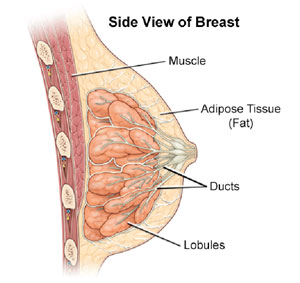
The breast, like any other part of the body, consists of billions of microscopic cells. These cells multiply in an orderly fashion. New cells are made to replace those that die.
In a cancer, cells multiply uncontrollably and progressively. Cancer beginning in the lactiferous duct, known as the ductal carcinoma, is the most common type. Cancer beginning in the lobules, known as lobular carcinoma, is much less common

 2017-06-28
2017-06-28 Breast
cancer is a type of cancer developing in breast cells. Breast cancer
usually begins in the inner lining of milk ducts or lobules supplying
milk. A breast cancer that starts off in the lobules is known as lobular
carcinoma, while one that developed from the ducts is called ductal
carcinoma. It should also be noted that a malignant tumour can spread to
other parts of the body. Daily Mirror spoke to Consultant Oncologist
Dr. Jayantha Balawardene on how breast cancer forms and spreads.
Breast
cancer is a type of cancer developing in breast cells. Breast cancer
usually begins in the inner lining of milk ducts or lobules supplying
milk. A breast cancer that starts off in the lobules is known as lobular
carcinoma, while one that developed from the ducts is called ductal
carcinoma. It should also be noted that a malignant tumour can spread to
other parts of the body. Daily Mirror spoke to Consultant Oncologist
Dr. Jayantha Balawardene on how breast cancer forms and spreads. “Breast cancer is the most common cancer among females globally and in Sri Lanka. Though breast cancer is more common in women, it is also present in men. There are many factors that lead to the occurrence of breast cancer; the most common being genetics. It also occurs among unmarried women, childless women and those who have their first child after the age of 30 or during early puberty and late menopause.”
The anatomy of a female breast
A mature human female’s breast consists of fat, connective tissue and
thousands of lobules [tiny glands which produce milk]. The milk of a
breast-feeding mother goes through tiny ducts [tubes] and is delivered
through the nipple.

The breast, like any other part of the body, consists of billions of microscopic cells. These cells multiply in an orderly fashion. New cells are made to replace those that die.
In a cancer, cells multiply uncontrollably and progressively. Cancer beginning in the lactiferous duct, known as the ductal carcinoma, is the most common type. Cancer beginning in the lobules, known as lobular carcinoma, is much less common
Symptoms of breast cancer
Symptoms are felt by the patient and the first of these are usually an
area of thickened tissue in the woman’s breast, or a lump. The majority
of lumps are not cancerous; however women should get them checked by a
healthcare professional. 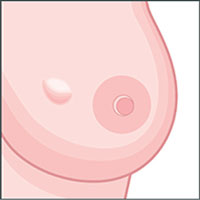

Some of the symptoms of breast cancer:
- A lump in the breast
- Pain in the armpits or breast that don’t seem to be related to the woman’s menstrual period
- Pitting or redness of skin in the breast resembling the skin of an orange
- Rash around [or on] one of the nipples
- Swelling [lump] in one of the armpits
- Area of thickened tissue in the breast
- A nipple discharge that may contain blood
- The nipple changes appearance, may become sunken or inverted
- The size or shape of the breast changes
- The skin of the breast or nipple may start to peel, scale or flake
Causes of breast cancer
- Genetics
Women who have a close relative who has/had breast or ovarian cancer are
more likely to develop the disease. Women who carry the BRCA1 and BRCA2
genes have a considerably higher risk of developing breast or ovarian
cancer. 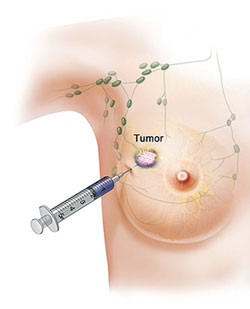

- Having had certain types of breast lumps
Women who have had some types of benign [non-cancerous] breast lumps are more likely to develop cancer later on
- Dense breast tissue
Women with denser breast tissue have a greater chance of developing breast cancer
- Estrogen exposure
Women who menstruated early or entered menopause later than usual have a
higher risk of developing breast cancer, as their bodies are exposed to
estrogen for a longer period of time.
- Obesity
Post-menopausal obese and overweight women may have a higher risk of developing breast cancer.
- Height
Taller-than-average women have a slightly greater likelihood of developing breast cancer.
- Alcohol consumption
The more a woman drinks, the higher her risk of getting breast cancer.
- Radiation exposure
Undergoing X-rays and CT scans may increase the risk of breast cancer
- HRT [Hormone Replacement Therapy]
Both forms, combined and estrogen only HRT therapies may increase a woman’s risk of developing breast cancer slightly.
There are two types of breast cancer known as Invasive and Non-invasive breast cancer.
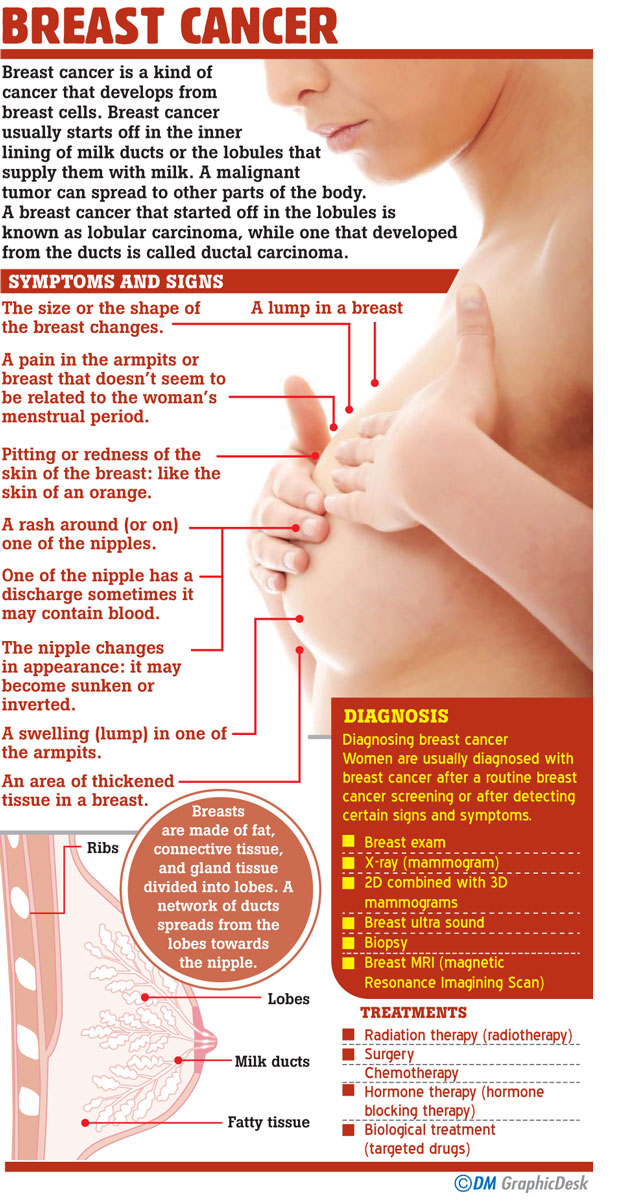
The cancer cells break out from inside the lobules or ducts and invade nearby tissue. With this type of cancer, the abnormal cells can reach the lymph nodes and eventually make their way to other organs (metastasis), such as the bones, liver or lungs.
Non-invasive breast cancer
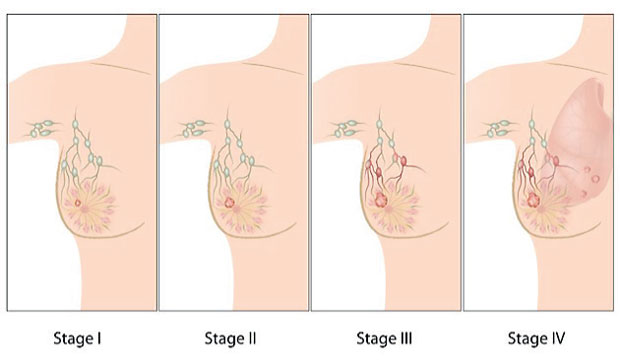
A cancer’s stage is a crucial factor in deciding what treatment options to recommend and in determining the patient’s prognosis. Staging is done after cancer is diagnosed. To do the staging, the doctor may order several different tests including blood tests, a mammogram, a chest x-ray, a bone scan, a CT scan, or a PET scan.
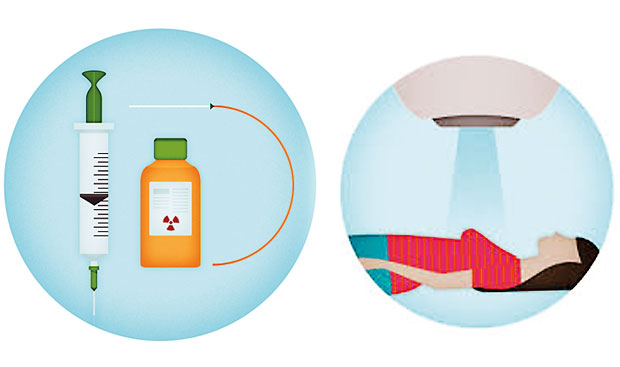
Hormone therapy (hormone blocking therapy)
Hormone therapy is used for breast cancers sensitive to hormones. The aim is to prevent cancer recurrence. Hormone blocking therapy is normally used after surgery but may sometimes be used beforehand to shrink the tumour.

Invasive breast cancer
The cancer cells break out from inside the lobules or ducts and invade nearby tissue. With this type of cancer, the abnormal cells can reach the lymph nodes and eventually make their way to other organs (metastasis), such as the bones, liver or lungs.
Non-invasive breast cancer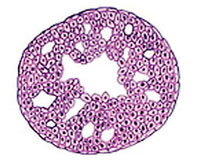
This is when the cancer is still in its place of origin and has not
broken out. Lobular carcinoma in situ is when the cancer is still inside
the lobules, while ductal carcinoma in situ is when they are still
inside the milk ducts. “In situ” means “in its original place”.
Diagnosing breast cancer
Women are usually diagnosed with breast cancer after a routine breast
cancer screening or after detecting certain signs and symptoms. 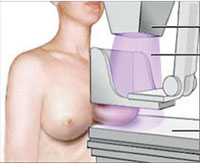

- Breast exam
- X-ray [mammogram
- 2D combined with 3D mammograms
- Breast ultra sound
- Biopsy
- Breast MRI [Magnetic Resonance Imagining Scan]
Breast cancer staging
Staging describes the extent of the cancer in the patient’s body and is
based on whether it is invasive or non-invasive, how large the tumour
is, whether lymph nodes are involved and how many and whether it has
metastasised [spread to other parts of the body].

A cancer’s stage is a crucial factor in deciding what treatment options to recommend and in determining the patient’s prognosis. Staging is done after cancer is diagnosed. To do the staging, the doctor may order several different tests including blood tests, a mammogram, a chest x-ray, a bone scan, a CT scan, or a PET scan.

Treatments for breast cancer
Radiation therapy (radiotherapy). Controlled doses of radiation are
targeted at the tumour to destroy the cancer cells. There are certain
types of Radiotherapy as:
- Breast radiation therapy

- Chest wall radiation therapy
- Breast boost
- Lymph nodes radiation therapy
- Breast brachy therapy surgery
There are many surgeries a patient can undergo to reduce breast cancer such as:
- Lumpectomy
- Mastectomy
- Sentinel node biopsy
- Auxiliary lymph node dissection
- Breast reconstruction surgery Chemotherapy
Medication used to kill cancer cells are known as Cytotoxuc drugs. The
Oncologist may recommend chemotherapy if there is a high risk of cancer
recurrence, or if the cancer is spreading elsewhere in the body. This is
called adjuvant chemotherapy.
Hormone therapy (hormone blocking therapy)
Hormone therapy is used for breast cancers sensitive to hormones. The aim is to prevent cancer recurrence. Hormone blocking therapy is normally used after surgery but may sometimes be used beforehand to shrink the tumour.
- Biological treatment (targeted drugs)
- Trastuzumab (Herceptin)
- Lapatinib (Tykerb)
- Bevacizumab (Avastin)
- Low-dose aspirin

